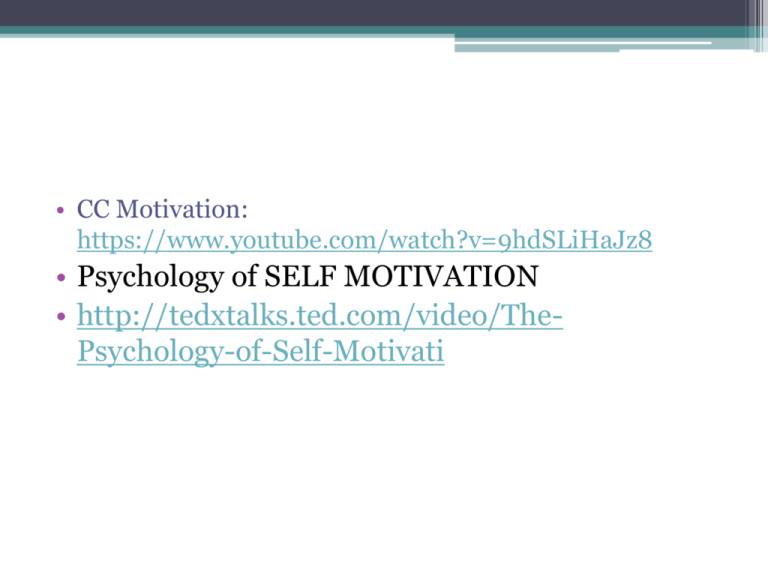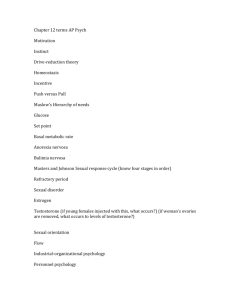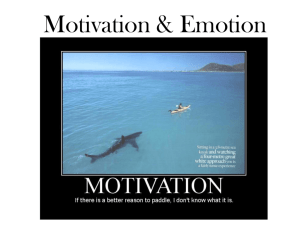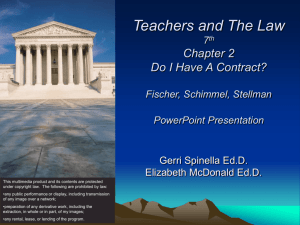
• CC Motivation:
https://www.youtube.com/watch?v=9hdSLiHaJz8
• Psychology of SELF MOTIVATION
• http://tedxtalks.ted.com/video/ThePsychology-of-Self-Motivati
1/12
• DO NOW:
▫ Turn in your 3 TYPES OF LEARNING handout
▫ Free write. Write down a few sentences about what
motivates you.
you
Why do
come to school? Why are you in an
AP course? Why are you applying to colleges, looking
for careers? Why do you get up and shower? Etc. etc…
Motivation and Emotion
• Materials: chapter 8A, 8B. Study Guide (note
changes in study guide)
▫ Due for M/E Unit = Study guide w/vocab and all
questions completed.
1st, 2nd, 8th= 1 reading quiz on Day 3
3rd and 5th = 5 unit review questions total from chapter 8
• Day 1 = Motivation. Chapter 8A: pgs. 327 -362
Theories
Hunger
Achievement
Eating disorders, obesity and weight
Sex, sexual orientation
• Day 2 = Motivation (finish),Emotions. Chapter 8B:
pgs. 366-396
• Day 3= Stress and Health. Chapter 8B: pgs. 397-406
Aron Ralston
Survivor: The Aron Ralston Story
http://www.youtube.com/watch?v=SyPBTblkzBI
Aron Ralston Project
Discuss Aron Ralston’s experience using the
following psychological principles. Use specific
examples and events to illustrate each psychological
concept or theory.
•
•
•
•
•
Drive reduction theory
Arousal theory & sensation seeking (Type T’s)
Maslow’s Hierarchy of Motives
Opponent-process theory of emotion
Cognitive Dissonance theory
I CAN:
• Define Motivation
• Distinguish the 6 types of motivation (Drive,
Motive , Intrinsic Motivation , Extrinsic
Motivation, Conscious Motivation, Unconscious
Motivation)
• Describe a time overjustification interfered with
your motivation
Copyright © Allyn &
Bacon 2007
Motivation: What Makes Us
Act as We Do?
Motivation takes many
forms, but all involve inferred
mental processes that select
and direct our behavior
Motivation may be…
conscious "I'll need a good grade, so I'll study"
or
unconscious nibbling on food while you're studying
Motivation
▫ Mental processes that select and
direct our behavior
Why We Do Things
Copyright © Allyn & Bacon 2007
Copyright © Allyn &
Bacon 2007
Copyright © Allyn &
Bacon 2007
Types of Motivation
• Drive
• Motive
• Intrinsic Motivation
• Extrinsic Motivation
• Conscious Motivation
• Unconscious Motivation
Drives “Push” and Incentives “Pull”
Drives are based
on inner needs
and can be seen
as a force
“pushing” from
inside of us.
Incentives are
external stimuli
that either
appeal to our
needs or trigger
our aversive
feelings, and can
be used to “pull”
us in our actions.
For example:
we have a drive to have food, or money we can exchange for
food.
employers can use the prospect of a raise in (or elimination
of) salary as an incentive for us to follow employer goals and
policies.
Drive
Copyright © Allyn &
Bacon 2007
Biologically instigated motivation
• Hunger
• Thirst
• Sex
Motive
The internal mechanism that selects and directs
behavior
Urges that are mainly learned rather than biologically based
• The desire to play video games
• The Need for Achievement
Intrinsic Motivation
Desire to engage in an activity for its own sake
• This comes from ‘within’ the person
Extrinsic Motivation
Copyright © Allyn &
Bacon 2007
Desire to engage in an activity to achieve an
external consequence…like a reward
The anticipation of a reward will
continue to be a motivator even
when the task holds little or no
interest.
An extrinsically motivated student
may have no interest in the
subject, but the possibility of a
good grade is enough to keep the
student motivated
Personal examples?
Conscious Motivation
• Having the desire to engage in an
activity and being aware of the
desire
Unconscious Motivation
• Having a desire to
engage in an activity
but being consciously
unaware of the desire
A talented
basketball player who plays poorly in a
Freud: repressed desires, impulses, memories influence
game
could unconsciously be punishing an overmotivation
demanding father or coach
Theories of Motivation
1.
2.
3.
4.
Instinct Theory
Drive Theory: aka Drive Reduction Theory
Cognitive Theory
Locus of Control (Internal and
external)
5. Maslows’s Humanistic Theory
(Hierarchy of Needs)
6. The Arousal Theory
Jigsaw learning
• In groups of 5-6 you’ll be assigned a theory. You
will become the expert of that theory and teach
the class using the following:
▫ Definition of the theory
▫ Example of theory
• 20 minutes to collaborate, and prepare to share
out
Instinct Theory:
One of the oldest theories comes from the field that we
know today as Evolutionary Psychology
Charles Darwin: human behavior is driven by innate
instinctual drives (unlearned) like those for some birds
& fish.
However, this theory soon revealed its limitations in
that it could only describe the behavior of humans
but not provide an explanation.
Examples:
★ Sea Turtles, upon being born on the beach,
instinctively head directly to the sea.
★ Infants have an inborn rooting reflex that helps
them seek out a nipple & obtain nourishment.
★ Birds have an inborn need to build a nest or
migrate during the winter.
"To qualify as an instinct, a complex
behavior must have a fixed pattern
throughout a species and be
unlearned. Such behaviors are common
in other species. Human behavior, too,
exhibits certain unlearned fixed patterns,
including infants' innate reflexes for
rooting & sucking. Most psychologists,
though, view human behavior as
directed by both physiological needs &
psychological wants."
(Myers, 2011)
Drive-Reduction Theory
Physiological need creates an aroused tension state
(a drive) that motivates an organism to satisfy the
need
Hull: Humans have innate biological needs (thirst)
& social needs (love)
Drives compel us to satisfy our needs
The need is usually to maintain homeostasis.
We are not only pushed by our needs...
Pulled by our incentives: a positive or
negative environmental stimulus that
motivates behavior
Thirst (need) feel an internal motivation (drive) to find
water to satisfy that need
Drive-Reduction Theory:
Do whatever is necessary to reduce the
unpleasant sensation.
Humans often act counter to this notion.
People will go on hunger strikes if they feel strongly about some
cause.
Motivation to not eat: greater than the
biological motivation to eat.
Arousal Theory
Sometimes we do not seek homeostasis, but
instead seek arousal.
Our needs go beyond reducing drives.
Stimulation is a primary need.
Too much stimulation causes stress, so homeostatic
processes are working here as well.
Some people exhibit a drive towards high-risk
situations that are uncomfortable without adrenaline
rush.
Others are content to watch and would feel
uncomfortable if they were forced to engage in highrisk behaviors.
Video: Real Life Spiderman 1:41
Copyright © Allyn &
Bacon 2007
• Internal
LOC
Locus
of
Control
• You control
• External LOC
• If you study, you
get a good grade
• Good grades are due
to luck or a biased
teacher
what happens to
you
• Outside
influences
control what
happen
Maslow’s Hierarchy of Needs
Copyright © Allyn &
Bacon 2007
Hierarchy of Needs
The notion that needs occur in priority
order, with the biological needs as the most
basic
Maslow’s Self-Actualization
Copyright © Allyn &
Bacon 2007
▫State of selffulfillment in
which people
realize their
highest potential
in their own
unique way
Copyright © Allyn &
Bacon 2007
Rewards
• Rewards don’t always
interfere with
intrinsic motivation
• For example, some
people love their job
and get paid for it
Airborne Toxic Event
Mini-assignment
1. READ THE STORY BELOW AND ANSWER THE QUESTIONS.
Rodney Denman was an outstanding volleyball player his first three years of high school,
but he did not perform as well in the classroom. At the end of his junior year, he
discovered that he would not be eligible for any college volleyball scholarships unless he
raised his grades. During his senior year, Denman's grades rose from a D average to a B+
average while his outstanding performance on the volleyball court continued.
a. Pick a theory of human motivation (instinct, drive reduction, arousal, or incentive).
b. Using this theory, explain Rodney Denman's change in behavior.
2.
Using ANOTHER theory of motivation, explain some behavior that YOU engage in.
Describe the behavior, then explain how the theory explains it.
Freud believed that humans have
only two basic drives:
Copyright © Allyn &
Bacon 2007
4. Psychodynamic Theory
1. Eros
The desire for sex
• 2. Thanatos
The aggressive,
destructive impulse.
• Virtually
everything we do
is based on one of
these urges
Copyright © Allyn &
Bacon 2007
Georgia O'Keefe
• Since these urges
are always
building, we
continuously
need to find
acceptable
outlets for our
sexual (artist
creating art) and
aggressive
(sports) needs
Homeostasis
Does not explain things like why
people play, which is rewarding in
itself without satisfying a drive
BREAK
• Define Motivation
• Distinguish the 6 types of motivation (Drive,
Motive , Intrinsic Motivation , Extrinsic
Motivation, Conscious Motivation, Unconscious
Motivation)
• Describe a time overjustification interfered with
your motivation
How Are Achievement,
Hunger, and Sex Alike? Different?
Copyright © Allyn &
Bacon 2007
No single theory accounts
for all forms of motivation,
because each motive
involves its own mix of
biological, mental,
behavioral, and
social/cultural influences
Do NOW
• Find “Motivation” study guide.
• Turn and talk to a neighbor about:
▫ Drive reduction theory
▫ Motive
▫ Intrinsic motivation
• Goals for today:
▫ Re-cover Theory
▫ Hunger, sex, sexual orientation and begin emotion
Hunger
Hunger
as Motivation
• Eating comes naturally
▫ If it was entirely learned,
probably starve before
learning it
Physiology of Hunger
BIOLOGICAL
MOTIVATION:
Hypothalamus: region of
brainyou
mostwould
often
associated w/ motivation
Motivation: feeding,
fighting, fleeing, &
sexual reproduction.
Copyright © Allyn &
Bacon 2007
Washburn: showed hunger
Glucose: hormone insulin
partially related to the stomach.
converts glucose to fat.
**However, those persons who have
When glucose levels
had their stomachs removed still
drop:
feel hunger.
HUNGER INCREASES
Summary of Hypothalamus & Hunger
Along lower middle section of hypothalamus is the
ventromedial hypothalamus: depresses hunger
Stimulate the ventromedial hypothalamus & the
animal will stop eating
Lesion the ventromedial hypothalamus
the animal will continuously want to eat.
Along the sides of the hypothalamus is the
lateral hypothalamus:
which brings on hunger.
Stimulate the lateral hypothalamus &
even a well fed animal will begin to eat.
Lesion the lateral hypothalamus & a
starving animal will have no interest in food.
Hunger Drive
Hunger is probably the most researched of all physiological needs. Arises from a complex mixture of
external and internal factors:
External Factors
•
Stress - A person may eat to counteract
negative feelings produced by stress.
(Stress- unpleasant, Eating pleasant)
Certain foods release the
neurotransmitter serotonin, which has a
calming effect.
• Eating habits - Eating at fixed times of
the day, regardless of hunger.
• Food-related cues - Eat because food is
appealing to you, even though you are
not hungry. Eating dessert even though
you are full.
• Presence of eating cues - If you always
have a snack an hour before going to bed,
when the cock reaches that hour, it
motivates you to go and get food - hungry
or not.
Internal Factors
•
•
•
•
Hypothalamus - 2 factors, one monitors chemicals
related to the amount of glucose in the body. When
glucose drops, the hypothalamus produces sensation of
hunger. After the need has been met, other chemicals are
released that signal the feeling that you are full. A second
homeostatic system measures the amount of fats and
amino acids stored in the body's cells. When their levels
drop too low, hunger signals are switched on.
Basal Metabolic Rate - Each person burns food at a
different rate and expends energy with different
efficiency. A person with a high metabolic rate can eat
more without gaining weight than someone who is just as
active, but has a lower metabolic rate.
Body (basal) Set Point - Falling below that "set point" of
weight triggers biological processes that cause us to get
hungry more often.
Taste Sensation - Tastes is an important factor when we
first begin eating. It encourages us to continue. Before
long, the taste buds begin to shut down so that we are
willing to stop eating when we are full.
Set Point Theory
Hypothalamus acts as a thermostat.
We are meant to be in a certain weight range.
When we fall below weight our body will increase hunger
& decrease energy expenditure (Basal Metabolic Rate)
What happens if we go above our set point?
Theory states we will auto correct to lower point.
Copyright © Allyn &
Bacon 2007
Motivation and Hunger
Copyright © Allyn &
Bacon 2007
The
hypothalamus
controls eating
and other body
maintenance
functions
Copyright © Allyn &
Bacon 2007
Eating Disorders
Anorexia Disorder
• significantly underweight (15% or more); feel fat and fear obesity; limited food intake
• 2 types of anorexia
• restricting type
▫
▫
▫
dieting
fasting
excessive exercise
• binge-eating/purging type
▫
▫
•
•
•
•
•
self-induced vomiting
misuse of laxatives, diuretics, or enemas
Binge-purge types are more likely to:
have problems with impulse control
abuse alcohol & other drugs
have more labile moods
be sexually active
BULIMIA NERVOSA
• binge eating
• Bulimics are typically normal weight.
Binge eating typically occurs in secret.
• What are inappropriate ways of
preventing weight gain?
• vomiting (80-90% of bulimics)
• Binge eating is often triggered by:
▫ dysphoric mood states
• fasting
▫ interpersonal stressors
▫ intense hunger following dietary
restraint
▫ feelings related to body weight,
body shape, and food
• excessive exercise (that interferes with
important activities, occurs at
inappropriate times or settings, or
continues despite injury or medical
conditions)
• not taking insulin (in diabetics)
• About 1 to 3 % of adolescent and
young adult females are bulimic
Women’s Body Images
1 – 5 Scale
Copyright © Allyn &
Bacon 2007
• The Thinning of Miss America
Copyright © Allyn &
Bacon 2007
Trend in Body Mass Index (BMI) of Miss America Pageant Winners
24
BMI, kg/m²
23
22 •
21 •
20
19
18
17
16
15
•
Trend line
•
•• • • •
• •
• •••
•
•
• •
•• • •
•
• •
•
•
• ••• •
• •
• •
•
• •
World Health
•
Organization’s
•
cutoff point for
undernutrition (18.5)
•
•
1920 1930 1940 1950 1960 1970 1980 1990 2000
Year of Pageant
Video: Dove Evolution
Video: The Photoshop Effect
The Thirst Drive
• Volumetric Thirst
• A drop in extracellular
fluid levels
• (Fluid outside the cells, such as
in the blood)
Copyright © Allyn &
Bacon 2007
The Thirst Drive
Copyright © Allyn &
Bacon 2007
• Osmotic Thirst
• A drop in
intracellular fluid
levels
• Results from water
moving through the cell
walls…escaping in the
form of sweat, urine,
feces, mucus, breath
moisture
Pain
• Usually produces a drive to avoid or remove,
rather than seek, a stimulus.
1/14/2015
• Do NOW:
▫ Discuss why you think eating disorders are so
prevalent in Western society.
▫ explain the Arousal theory.
Give an example of a famous person who might be an
extreme in this theory.
• Today:
▫ finish Motivation-sex, sexual orientation, conflict
▫ Emotion: Eckman, universals, (maybe) theories
Sex and Motivation
• Sex in NOT a homeostatic drive because it does
not return the body to a state of equilibrium
• The brain is the major sex organ in humans
Sexual Drive:
Pleasure that organisms derive from sex ensures that they
will procreate, helping their species survive.
Like hunger, it is a complex interaction involving chemistry,
biology, & psychology.
Chemistry - the release of specific
chemicals in the body triggers the emotions
we associate with sex drive.
Cognition - plays an important role in
mediating the sex drive.
Just as cultural beliefs play a role in determining the foods one
will eat or avoid, personal values and cultural customs are
determining factors in when, how, and with whom one
satisfies the sex drive.
A Primary Need - However... sexual activity
is also associated with higher needs in
Maslow's hierarchy, such as belonging,
avoidance of loneliness, and self-esteem.
Kinsey’s Studies
Confidential interviews with
18,000 people (early 1950’s).
Most men and half of all
women have premarital sex.
Good beginning, however major
problems with his study included
sampling size & questionnaires.
The Physiology of Sex
1960’s William Masters and Virginia
Johnson set out to explore the physiology
of sex.
382 females & 312 males
Only people who were willing to have sex &
display orgasm in a lab environment.
Filmed more than 10,000 sex cycles.
Discovery of The Sexual Response Cycle (4
Stages)
★ Excitement Phase
★ Plateau Phase
★ Orgasm
★ Resolution Phase
The Physiology of Sex
People can find sexually explicit images
either pleasing or disturbing- but they
are none the less biologically arousing.
Viewing erotic materials:
★ changes ones attitudes to be more
liberal about sexual practices.
★ may make some people dissatisfied
with their own sexual interactions.
★ elevates the likelihood of overt
sexual activity for a few hours
immediately after the exposure.
Pheromones appear to be important
in lower animals determinants of
sexual desire in but of limited
relevance to humans.
Adolescent Sexuality
Cultural Acceptance
About ½ of all high school kids in US report having sex.
Rates are higher in Western Europe but lower in Arab or Asian countries.
Also change over time in the same culture:
In 1900 3% of women reported having sex by 18. Now that number is around 1/2.
Hormones and Sexual Motivation
Sexual motivation may have
evolved to enable creatures to pass
on their genes. Sexual desire and
response is not as tied to hormone
levels in humans as it is in animals.
During ovulation, women show a
rise in estrogen and also in
testosterone.
As this happens, sexual desire
rises in women and also in the
men around them (whose
testosterone level rises).
Low levels of testosterone can
reduce sexual motivation.
Sexual Scripts
• Socially learned
ways of
responding in
sexual
situations
• Both learning
and genetics
affect our
sexual
behaviors
Origins of Sexual Orientation
Theories suggesting that
sexual preference is related
to parenting behaviors or
childhood abuse are not
supported by evidence.
Differences appear to begin
at birth. This could be
genetic, or it could be
caused by exposure to
hormones or antigens in
the womb.
The fraternal birth order
effect: being born after a
brother increases the
likelihood of being gay.
Cause or Effect?
The brain and other
differences in sexual
orientation
Heterosexual men have a
certain cell cluster in the
hypothalamus that, on
average, is larger than in
gay men and in women.
Gay men are more likely
than straight men to be
poets, fiction writers,
artists, and musicians.
Genetics and Homosexuality
In fruit flies, a difference in one gene
determined sexual orientation and behavior.
Homosexuality seems to run in families and
among identical twins, but still emerges
spontaneously, even in one of a pair of twins.
Genes related to homosexuality could be
passed on by siblings or by people not living
exclusively according to their sexual
orientation.
Homosexuality and Gender
Hormones that affect gender may also affect sexual orientation.
In mammals, female fetuses exposed to extra testosterone, and
male fetuses exposed to low levels of testosterone, often grow
up with:
bodies, brains, and faces with traits of the opposite sex.
the sexual attraction expected of the opposite sex to one’s
own sex.
The Origins of Sexual Orientation
Copyright © Allyn &
Bacon 2007
Copyright © Allyn &
Bacon 2007
• Watch video Case studies of sexual orientation in
twins
• http://www.schooltube.com/video/8526c911d9e33a
e837ad/Case-studies-of-sexual-orientation-in-twins
Motives in Conflict
• Approach-Approach Conflict
•
A conflict in which one must choose
between two equally attractive options
• Finishing college and a full-time job offer
• Easiest conflict to resolve
Copyright © Allyn & Bacon 2007
Motives in Conflict
• Approach-Avoidance
Conflict
•
A conflict in which there are both
appealing and negative aspects to the
decision to be made
• Going out to a party, knowing that you
will be grounded for being at the party.
Copyright © Allyn & Bacon 2007
Motives in Conflict
•Avoidance-Avoidance
Conflict
•
A conflict in which one must choose
between two equally unattractive
options
• You intensely hate your job, but fear
the reality of unemployment if you quit
Copyright © Allyn & Bacon 2007
Motives in Conflict
• Multiple Approach-Avoidance
Conflict
•
A conflict in which one must choose
between options that have both many
attractive and many negative aspects
Go to the Party
Go to the Party
Meet friends
Have a good time
Aren’t alone
Aren’t bored
Get grounded
Don’t study for a test
…fail it
Do something stupid that
you’ll regret
Copyright © Allyn & Bacon 2007
Break
• Emotions discussion
CAN I?
• Explain need for achievement, affiliation, power
• Explain cultural differences in achievement
• Explain weight trends and cultural influences
involving hunger/weight
• Describe the contributions of Alfred Kinsey and
Master’s and Johnson in the study of sex
• Distinguish the 4 motives in conflict
Personnel
psychology:
hiring and evaluating
The Psychology of
the Workplace:
IndustrialOrganizational
[I/O]Psychology
I/O psychology includes
three different areas of
focus
Organizational
psychology:
management,
supervision, leadership,
and teamwork
Human factors
psychology:
how workers interface
with machines and the
environment
Organizational Psychology
Goals of Organizational
Psychology Research
Organizational
psychology:
studying and
consulting about
how worker
productivity and
motivation is
affected by
different patterns
of workermanagement
engagement,
leadership, and
teamwork
Maximizing worker motivation,
satisfaction, and productivity
Understanding organizational
structures and dynamics
Facilitating organizational change
Improving teamwork and
leadership
Grit:
Motivation to Achieve
and Self-Discipline to
Succeed
Organizational psychologists
work in part to maximize
motivation and put it to use
for employers.
Grit refers to a combination
of desire for achievement and
the ability/willingness to
persist at hard work.
Success in careers and
organizations may be caused in
part by people with grit, who
stick to a goal when others
would have quit.
77
Achievement in most fields of
work may seem like a function of
talent; however, Thomas Edison
noted that, “genius is 1 percent
inspiration, 99 percent
perspiration.”
Talent itself can be a result of
perseverance. According to the
“ten year rule,” it takes about ten
years of hard work to become a
skilled expert in a field.
Success in work is predicted
more by self-discipline than by
intelligence test scores.
A Cross-Cultural Perspective on
Achievement
• Individualism
• Collectivism
Copyright © Allyn &
Bacon 2007
View that places a high value on
individual achievement and
distinction
• Common in the Western
world…Europe, the U.S.
View that values group
loyalty and pride over
individual distinction
• Common in Asia,
Africa, Latin America,
Middle East
BIOLOGICAL MOTIVATION
Evidence: Lateral Hypothalamus provides
motivation for hunger or feeding:
Lesion Lateral Hypothalamus in a rat,
rat will lose its appetite.
Rat will experience a form of anorexia in
which it will not be hungry &, therefore, will
not eat.
-------------------------------------------------Evidence: Ventromedial Hypothalamus as
the satiety center (part of brain that signals
you are full):
Lesion Ventromedial Hypothalamus, rat will
not feel full.
Rat will continue to eat well beyond what
is normally expected.







